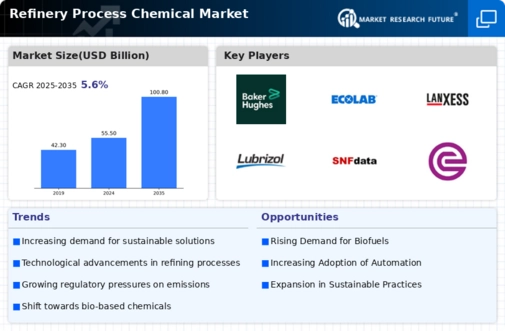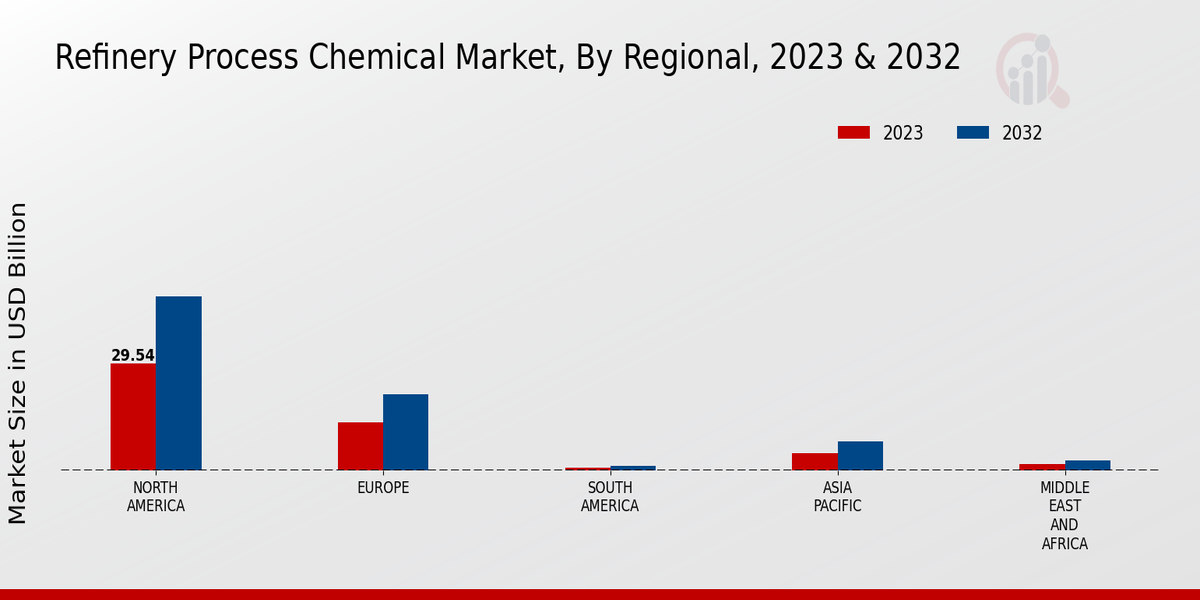Global Economic Growth
The Global Refinery Process Chemical Market Industry is closely tied to global economic growth. As economies expand, the demand for energy and refined products increases, driving refinery operations. Emerging markets, in particular, exhibit significant growth potential, as rising incomes and urbanization lead to higher energy consumption. The projected CAGR of 5.57% from 2025 to 2035 indicates a robust outlook for the industry. This growth is likely to be fueled by investments in infrastructure and energy projects, further solidifying the Global Refinery Process Chemical Market's position in the global economy.
Rising Demand for Fuels
The Global Refinery Process Chemical Market Industry experiences a surge in demand for fuels, driven by increasing energy consumption worldwide. As urbanization and industrialization continue to expand, the need for refined petroleum products escalates. In 2024, the market is projected to reach 55.5 USD Billion, reflecting the growing reliance on fossil fuels. This trend is further supported by government policies promoting energy security and self-sufficiency. The industry's ability to adapt to changing regulations and consumer preferences will be crucial in meeting this demand, ensuring that the Global Refinery Process Chemical Market remains robust and competitive.
Technological Advancements
Technological innovations play a pivotal role in shaping the Global Refinery Process Chemical Market Industry. Advanced refining technologies, such as hydrocracking and catalytic reforming, enhance efficiency and yield, thereby reducing operational costs. These advancements not only improve the quality of refined products but also minimize environmental impact. The integration of digital technologies, including AI and IoT, further optimizes refinery operations. As the industry moves towards more sustainable practices, these technologies are likely to drive growth, positioning the Global Refinery Process Chemical Market for a promising future.
Market Trends and Projections
The Global Refinery Process Chemical Market Industry is characterized by various trends and projections that shape its future. Key metrics indicate a steady growth trajectory, with the market expected to reach 55.5 USD Billion in 2024 and 100.8 USD Billion by 2035. The anticipated CAGR of 5.57% from 2025 to 2035 suggests a favorable environment for investment and innovation. These trends reflect the industry's adaptability to changing market conditions and consumer preferences, positioning the Global Refinery Process Chemical Market for sustained growth in the coming years.
Growing Petrochemical Industry
The expansion of the petrochemical industry is a key driver for the Global Refinery Process Chemical Market Industry. As petrochemicals serve as essential feedstocks for various products, including plastics and chemicals, their demand continues to rise. This growth is anticipated to propel the refinery sector, as refineries adapt to produce higher quantities of petrochemical derivatives. By 2035, the market is projected to reach 100.8 USD Billion, reflecting the increasing interdependence between the refining and petrochemical sectors. This synergy is likely to enhance the overall market dynamics, fostering innovation and investment.
Regulatory Compliance and Environmental Standards
The Global Refinery Process Chemical Market Industry is significantly influenced by stringent regulatory frameworks aimed at reducing environmental impact. Governments worldwide are implementing stricter emissions standards and promoting cleaner production processes. Compliance with these regulations necessitates the adoption of advanced refining chemicals and technologies, which can enhance operational efficiency. As refineries invest in cleaner technologies to meet these standards, the market is expected to grow. This trend indicates a shift towards sustainability, positioning the Global Refinery Process Chemical Market as a leader in environmentally responsible practices.




















